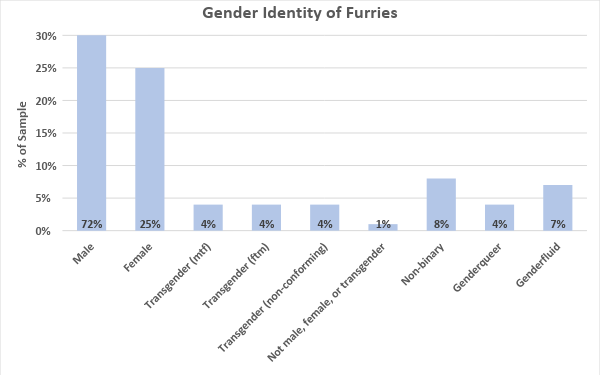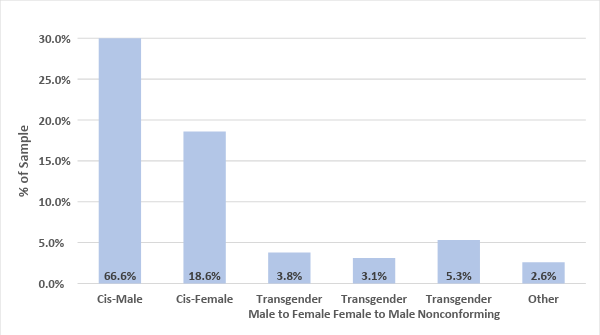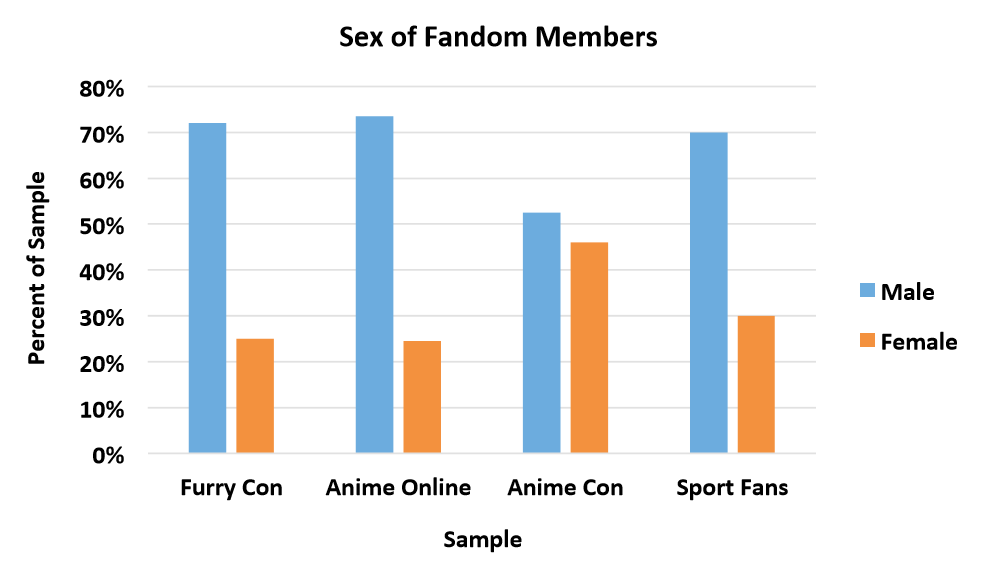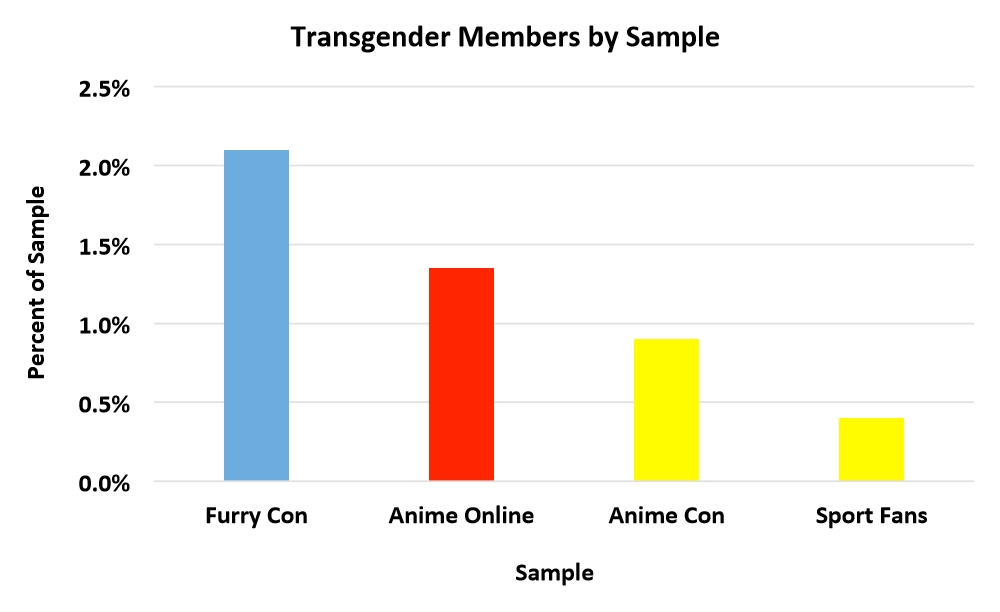In the social sciences, sex and gender are recognized as distinct concepts. Sex is typically conceptualized as an element of a person’s biologicy, whereas gender, which is socially constructed, refers to aspects of a person’s psychology (e.g., behaviour, self-perception). While a person’s gender identity is congruent with their sex in many cases (cis-gender), it is possible for their gender identity to differ from their sex (transgender), or to fluctuate fluidly over time.
As our awareness of sex and gender issues continues to evolve, we have continually striven to find better ways to meaningfully assess these facets of a personality without unnecessarily constraining participants to dichotomous responses or responses that do not fit with their lived life. To this end, we adopted new measures to assess this facet of identity1, significantly building upon the methods used in previous years 2 while avoiding the pitfalls and mistakes we commonly found ourselves running into. While far from the last word on the subject, the present measure does take into account much of the invaluable feedback provided to us by participants from past studies.
Participants were asked to check off which of a number of options they felt described them. They were free to check off as many or as few options as they wished, and were given the option to write in their own option at the end.
Furry Identification
We next assessed participants’ gender identity,3 giving them a series of options to choose (including the abilitiy to write in their own option), and allowing them to choose as many options as suited them (which is why the results add up to greater than 100%). The results found that the majority of furries identify as male, although one-quarter of furries identify as female. Transgender, genderfluid, and non-binary furries are also present at rates considerably higher than observed in the general population.
In an effort to estimate approximate proportion of furries in the fandom who identify as transgender, participants were asked to pick one option from a choice of six which best described them (with an option to provide their own answer if appropriate).4This was done to avoid “double-counting” anyone who identified with more than one category. As the figure above illustrates, 12.2% of furries fall within the broad category of “transgender”, a number more than 20 times higher than that typically observed in the general population. In short, the data from these questions illuminates the importance of considering transgender, genderqueer, and other non-binary gender identities when understanding the composition of the furry fandom, as they make up a considerable proportion of the fandom.
Consistent with past research5, the data suggest that self-identified males were roughly three times more prevalent in the fandom than self-identified females. Even more fascinating, however, is the fact that the number of transgender furries is, all told, nearly ten times higher than that estimated for the general American population (estimated at 0.6%6). It should also be noted that a considerable proportion of the furry fandom indicates that they do not fall within a traditional binary gender dimension, considers themselves to be genderfluid, or to be without a gender identity altogether.
Later in the study, participants were asked to indicate the extent to which they believed that gender diverse individuals were accepted in the furry fandom. If it were the case that gender diverse individuals were not typically accepted in the furry fandom, we might expect them to indicate that this was the case by disagreeing with the statement more than those who identified with more traditional gender identities, who might be unaware from first-hand experience that this was occurring. The results showed that both groups agreed to the same extent that gender diverse people were well-accepted within the furry fandom (6.22 / 7.00).
In prior studies7, we compared the furry fandom to three other fandoms: the online anime fandom, the anime convention fandom, and the fantasy sports fandoms. The proportion of furries self-identifying as male is similar to the proportions shown in the online anime and fantasy sports fandom, but far more male than the convention-going anime fandom.
While the ratio of self-identified males to females within the furry fandom does not appear to differ significantly from other online fandoms, the furries in this sample were significantly more likely to identify as transgender or genderqueer/non-binary (indicating that their gender identity fluctuates or does not fall on the Man-Woman dimension), compared to the other fandoms in the study, as the figure below shows8. Further research may show whether this indicates fandom-level differences in the inclusiveness of the groups studied or perhaps a preferential pull toward some other aspect of the furry fandom.
Interestingly another study of furries9 revealed that those furries assigned female at birth were more than twice as likely to identify as transgender (5.5%) and genderqueer or non-binary (18.9%) than furries assigned male at birth (2.1% and 4.1% respectively). The reason for this considerable difference is not yet known, and likely to be a topic for future research.
Research on transgender and genderqueer people within the furry fandom also corroborates findings from the broader psychological research on these populations as well. Studies suggest, for example, that transgender people are at a significantly greater risk for suicide and are more likely to experience significant stress and anxiety. These numbers are also reflected in samples of furries, where transgender and genderqueer furries are also significantly more likely to have reduced psychological well-being and experience significantly greater difficulty developing a positive, distinct, mature identity.10 While we hypothesize that transgender and genderqueer furries may be doing better than those outside the fandom, it remains for future studies to test these hypotheses.
As a whole, the data collected through our current survey methods supports our prior findings: across the fandoms the IARP has studied, the furry fandom may be the one most open to, or accepting of, people who eschew or challenge traditional gender norms. This may, in part, have to do with the content of the furry fandom, which allows a person’s created fursona to be any species, age, or gender, they wish—something that may appeal to people who otherwise feel limited in their ability to express their felt gender identity. This possibility is a topic of interest for future research.
References
- Anthrocon 2017 Study, Anthrocon 2018 Study
- 2014 3-Fandom Survey (Furries, Anime Fans, Fantasy Sport Fans)
- Anthrocon 2018 Study
- Anthrocon 2018 Study
- Please see the 2012 Furry Fiesta and International Online Furry Survey III; 2011 Anthrocon and International Online Furry Survey II; 2014 3-Fandom Survey (Furries, Anime Fans, Fantasy Sports Fans)
- Williams Institute, Flores et al., 2016, “How Many Adults Identify as Transgender in the United States“
- IARP 2014 3-fandom study
- Please see the 2012 Furry Fiesta and International Online Furry Survey III; 2011 Anthrocon and International Online Furry Survey II; 2014 3-Fandom Survey (Furries, Anime Fans, Fantasy Sports Fans)
- Anthrocon 2015 Study
- Anthrocon 2015 Study





“Sex refers to a person’s genetics (e.g., XX, XY, XO, XXY chromosomes),”
Find me a single dictionary that corroborates this.
http://www.furryresearch.org/findings/demographics/1-3-sex-and-gender/
https://medical-dictionary.thefreedictionary.com/sex
sex [seks]
…
3. sexual intercourse
chromosomal sex – the sex as determined by the presence of the XX (female) or the XY (male) genotype in somatic cells, without regard to phenotypic manifestations. [Also called] genetic sex.
These surveys dealt with Gender Identity, which is distinct from chromosomal or hormonal sex.
Which is why the first sentence reads “In the social sciences, sex and gender are recognized as distinct concepts” 😉
Furries arent tolerant at all. Not even close. Neither are Trans people. They hate gays (like myself) and lesbians.
We’re sorry this has been your personal experience; however, although this doesn’t invalidate your experience, the data don’t support this generally. In one of our current studies, N=414, 91% of furries strongly agreed (defined as reporting 6 or 7 on a 1-7 Likert Scale) that they were accepting of transgender and gender non-conforming furries in the fandom. 96% were strongly accepting of gay and lesbians. 96% were strongly accepting of straight furries.